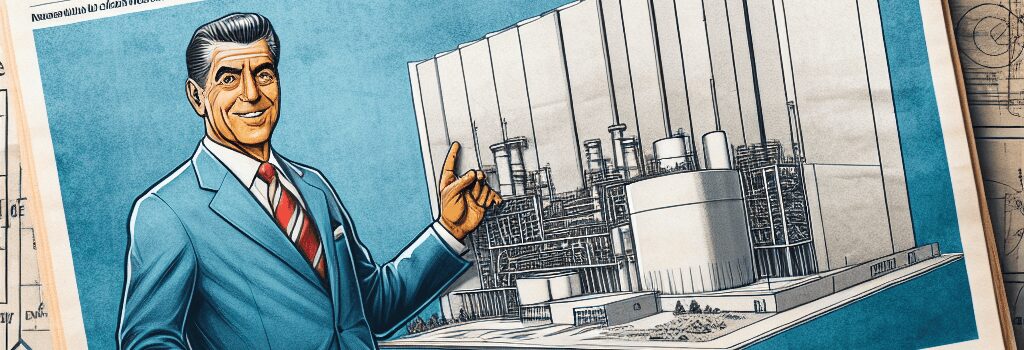Trump’s Plan to Revive U.S. Nuclear Power: A Deep Dive

Introduction
On May 27, 2025, President Trump signed a suite of executive orders aimed at reinvigorating the U.S. nuclear energy sector. The administration’s sweeping agenda promises to streamline licensing, accelerate deployment of advanced reactors, and shore up domestic supply chains. But can these measures overcome decades of regulatory, economic, and logistical roadblocks? Below, we unpack the technical details, policy shifts, and industry implications — plus expert insights and up-to-date developments.
Current Landscape of U.S. Nuclear Power
As of spring 2025, the U.S. nuclear fleet consists of 93 reactors providing roughly 100 GW of baseload capacity — about 20% of national electricity generation. Yet no new large reactors are under active construction, and only one small modular reactor (SMR) design, NuScale’s 77 MWe module, holds an approved NRC design certification.
Historical Slowdown
- 1970s–80s boom: Over 200 reactors ordered; three-quarters completed.
- Post–Three Mile Island (1979): Project delays spiked, cost overruns soared above 200% of initial estimates.
- 1990–2025: Only three new reactors connected to the grid; average commissioning delay of eight years.
Economic and Supply Chain Challenges
A 2023 MIT report estimated overnight capital costs for new large reactors at $6,000–8,000 per kW, versus $1,000–2,000/kW for utility-scale solar PV. Industry studies highlight:
- Fragmented supplier base: Only two U.S. vendors can fabricate large-forged reactor pressure vessels.
- Stalled parts inventory: Lead times of 24–36 months for steam generators and control-rod drive mechanisms.
- Skilled labor shortage: Welding, instrumentation, and non-destructive examination (NDE) capacity below 50% of peak 1980s levels.
Key Executive Orders: Provisions and Timelines
The new orders fall into two categories: regulatory reform at the Nuclear Regulatory Commission (NRC), and direct Department of Energy (DOE) initiatives for advanced reactors.
1. Regulatory Acceleration at the NRC
- 18-month design certification cap: License reviews for reactor designs must conclude within 18 months, down from an average of 36.
- 18-month construction & operating license (COL) reviews: Site-specific combined licenses to be issued within 18 months post–design approval.
- Risk-informed, performance-based standards: Incorporation of stress-test data from post-Fukushima upgrades and consideration of probabilistic safety assessments (PSA) to set “science-based” radiation exposure limits.
- Modular certification regime: One-time generic design certification for SMRs and Gen IV reactors; subsequent projects only require site-specific safety analyses.
2. DOE’s Advanced Reactor Deployment
- Three test reactors by July 4, 2026: Contracts to be awarded under the Advanced Reactor Demonstration Program (ARDP) for demonstration of at least 50 MWe output and 90% capacity factor.
- Army microreactor pilot: A 5 MWe reactor using high-assay low-enriched uranium (HALEU) to orbit a forward operating base by 2028.
- 10 large reactors under construction by 2030: DOE loan guarantees and public–private partnerships to kick-start Generation III+ projects, targeting 1.2–1.8 GW units.
Additional Technical Analyses
Reactor Design Innovations
Startups such as TerraPower, X-Energy, and Kairos Power are championing Gen IV concepts:
- Molten Salt Reactors (MSR): Liquid-fuel systems with passive safety features; core temperatures up to 700 °C enable higher thermal efficiencies (~45%).
- High-Temperature Gas-Cooled Reactors (HTGR): TRISO fuel particles within graphite pebbles; inherent negative feedback yields core meltdown resistance.
- Lead-Cooled Fast Reactors (LFR): Fast-neutron spectrum for closed fuel cycles and on-site transmutation of long-lived actinides.
Supply Chain and Manufacturing Bottlenecks
Rebuilding a domestic nuclear industrial base will require:
- Forging capacity: U.S. Steel and Rolls-Royce collaboration to revamp 5,000 ton forging presses for single-piece reactor vessels.
- Advanced fabrication: Adoption of additive manufacturing (AM) for complex internal core components, reducing lead times by up to 40%.
- Workforce development: Expanded Nuclear Energy University Program (NEUP) scholarships and a proposed $200 million DOE grant for vocational training in radiological instrumentation and welding.
Economic Models and Financing Strategies
Given high capex and long payback periods, experts argue for alternative financing:
- Regulated asset base (RAB) model: Consumers pay a small surcharge during construction, lowering financing rates from 8% to ~4%.
- Green bonds & carbon credits: Tax-exempt bonds and tradable credits at $50/ton CO₂ could reduce levelized cost of electricity (LCOE) to $0.08/kWh.
- Full government build: DOE directly funds and operates initial Gen IV facilities, mirroring DOE’s Manhattan Project–era approach.
Global Context and Geopolitical Implications
Internationally, China and Russia are exporting Gen III+ reactors (ACP1000, VVER-1200) under state-backed financing packages. U.S. re-entry into nuclear exports hinges on domestic licensing reforms and HALEU supply (enriched to 19.75%). Under the new orders, the DOE must develop a 10 t/yr HALEU enrichment capability by 2030 — enough to fuel four 300 MWe reactors annually.
Expert Opinions
“Cutting NRC review times is only half the battle — you need shovel-ready manufacturing lines and a stable investment climate,” says Dr. Maria Gonzalez, senior analyst at the Energy Policy Institute. “Otherwise, timelines will slip just as they have for the past 30 years.”
“Gen IV concepts could change the game, but they must clear a rigorous probabilistic risk assessment hurdle. DOE’s proposed ‘expedited’ environmental reviews concern me if corners get cut on seismic or floodplain studies,” warns former NRC Commissioner John O’Reilly.
Conclusion
The Trump administration’s executive orders are the most ambitious nuclear revival plan in decades, targeting regulatory reform, supply chain revitalization, and accelerated deployment of advanced reactors. However, without parallel efforts to rebuild manufacturing capacity, secure HALEU supply, and establish innovative financing models, the goal of tripling U.S. nuclear capacity to 400 GW by 2050 may remain aspirational. The coming months will reveal whether these directives translate into tangible breakthroughs — or fade as another round of well-intentioned but underfunded policy initiatives.